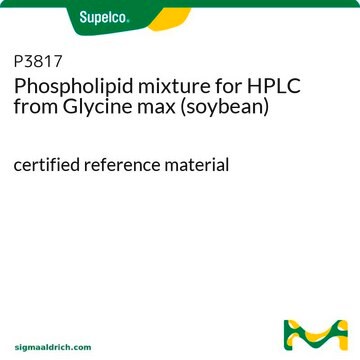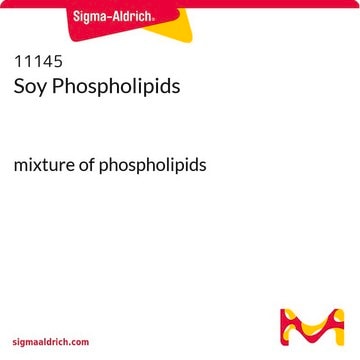If this product has an expiration or retest date, it will be shown on the Certificate of Analysis (COA, CofA). If there is no retest or expiration date listed on the product's COA, we do not have suitable stability data to determine a shelf life. For these products, the only date on the COA will be the release date; a retest, expiration, or use-by-date will not be displayed.
For all products, we recommend handling per defined conditions as printed in our product literature and website product descriptions. We recommend that products should be routinely inspected by customers to ensure they perform as expected.
For products without retest or expiration dates, our standard warranty of 1 year from the date of shipment is applicable.
For more information, please refer to the Product Dating Information document: https://www.sigmaaldrich.com/deepweb/assets/sigmaaldrich/marketing/global/documents/449/386/product-dating-information-mk.pdf
MAK122
Phospholipid Assay Kit
sufficient for 100 colorimetric or fluorometric tests
Sinónimos:
Phospholipid Quantification Kit
Seleccione un Tamaño
514,00 €
Seleccione un Tamaño
About This Item
514,00 €
Productos recomendados
uso
sufficient for 100 colorimetric or fluorometric tests
aplicaciones
cosmetics
food and beverages
pharmaceutical
método de detección
colorimetric
fluorometric
Condiciones de envío
dry ice
temp. de almacenamiento
−20°C
Categorías relacionadas
Descripción general
In this assay, phospholipids (such as lecithin, lysolecithin and sphingomyelin) are enzymatically hydrolyzed to choline which is determined using choline oxidase and a H2O2-specific dye. This results in a colorimetric (570 nm)/ fluorometric (λex = 530/λem = 585 nm) product directly proportional to the phospholipid concentration in the sample. The range of linear detection is 3 - 200 μM for colorimetric assays and 0.6 - 20 μM for fluorometric assays.
Aplicación
Características y beneficios
Idoneidad
Principio
Palabra de señalización
Danger
Frases de peligro
Consejos de prudencia
Clasificaciones de peligro
Aquatic Chronic 3 - Resp. Sens. 1
Código de clase de almacenamiento
10 - Combustible liquids
Elija entre una de las versiones más recientes:
Certificados de análisis (COA)
¿No ve la versión correcta?
Si necesita una versión concreta, puede buscar un certificado específico por el número de lote.
¿Ya tiene este producto?
Encuentre la documentación para los productos que ha comprado recientemente en la Biblioteca de documentos.
Los clientes también vieron
-
How can I determine the shelf life / expiration / retest date of this product?
1 respuesta-
¿Le ha resultado útil?
-
-
How is shipping temperature determined? And how is it related to the product storage temperature?
1 respuesta-
Products may be shipped at a different temperature than the recommended long-term storage temperature. If the product quality is sensitive to short-term exposure to conditions other than the recommended long-term storage, it will be shipped on wet or dry-ice. If the product quality is NOT affected by short-term exposure to conditions other than the recommended long-term storage, it will be shipped at ambient temperature. As shipping routes are configured for minimum transit times, shipping at ambient temperature helps control shipping costs for our customers. For more information, please refer to the Storage and Transport Conditions document: https://www.sigmaaldrich.com/deepweb/assets/sigmaaldrich/marketing/global/documents/316/622/storage-transport-conditions-mk.pdf
¿Le ha resultado útil?
-
-
Is the 10 ml of Assay Buffer in MAK122 sufficient for 100 assays? Also, what amount of sample/buffer should be used?
1 respuesta-
1. The general recommendation for homogenization is a 1:10 solid to buffer ratio, for example, 20mg solid with 200 uL of Buffer. However, this ratio may not always be optimal. If there are concerns about having enough assay buffer for both homogenization and assays, the homogenization can be run with a different homogenization buffer, provided that it contains at least 0.5% Triton X-100. Please note that the amount of Assay Buffer needed per sample should be enough to yield 40 microliters of supernatant, unless you choose to use your own homogenization buffer with 0.5% Triton X-100.
2. The kit is usually tested on tissue samples. However, it has not been tested on tissues themselves.
3. For homogenizing samples, they can be run through 10-20 passes in a Dounce homogenizer on ice or by sonication, preferably performed in an ice-water bath. The degree of tissue lysis can be checked under a microscope. After homogenization, it is recommended to centrifuge the homogenate at 14,000 g for 10 minutes.
¿Le ha resultado útil?
-
-
Why is cold assay buffer listed as a potential cause for the assay not working correctly? Can a 37 or 25 degree water bath be used to thaw the assay buffer? Can the assay buffer be stored at room temperature instead of at -20 degrees?
1 respuesta-
The troubleshooting bulletin for MAK122 suggests that if the assay does not work, it could be due to the assay buffer not being at room temperature. This is because the enzyme is more active at room temperature than in colder conditions. Although stability data for the assay buffer at room temperature is not available, it is recommended to store it at -20 degrees or evaluate the suitability of room temperature storage. While the composition of the assay buffer is proprietary, it is expected to be stable at room temperature. Additionally, a 37 or 25 degree C water bath can be used to thaw the assay buffer, with a caution against excessive heating and a recommendation to remove it from the water bath once it reaches room temperature.
¿Le ha resultado útil?
-
-
To prepare the 0.5% Triton X-100 solution to dilute my samples, should I dilute Triton x-100 in water, in the assay buffer, or something else?
1 respuesta-
The 0.5% Triton X-100 solution to be used as the sample diluent may be prepared using water.
¿Le ha resultado útil?
-
Filtros activos
Nuestro equipo de científicos tiene experiencia en todas las áreas de investigación: Ciencias de la vida, Ciencia de los materiales, Síntesis química, Cromatografía, Analítica y muchas otras.
Póngase en contacto con el Servicio técnico






